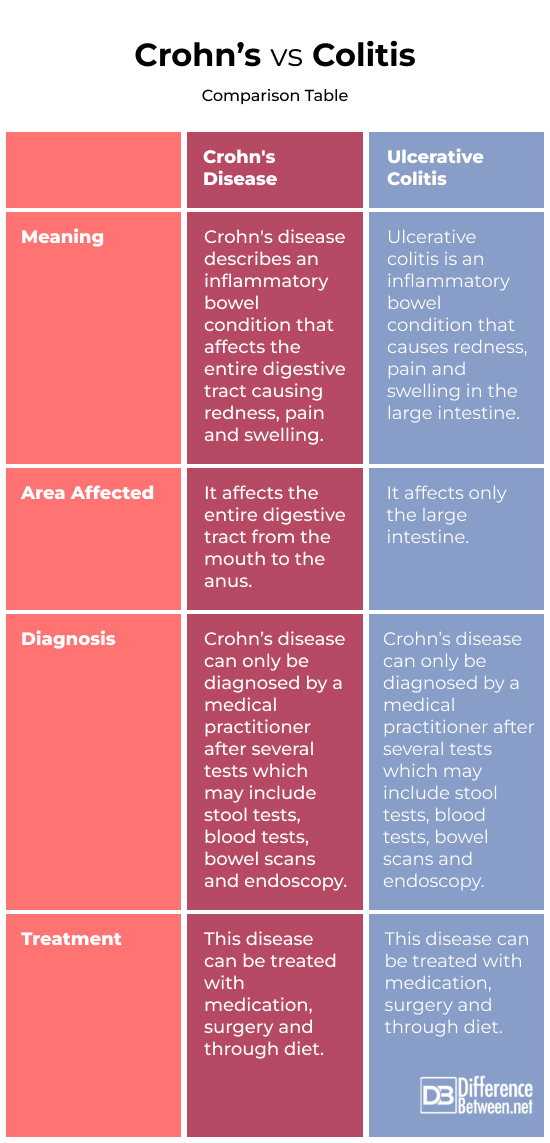Difference Between Crohn’s and Colitis
If you’ve been using the restroom more often than usual and are losing weight rapidly, it could be a sign of an underlying problem. You could be suffering from Inflammatory Bowel Disease (IBD). However, there are two diseases in this category: Crohn’s and ulcerative Colitis. Both illnesses have many similarities, as well as key differences. This piece will highlight the key points about both types of Inflammatory Bowel Disease.

What is Crohn’s?
As earlier stated, Crohn’s disease is a type of inflammatory bowel disease that leads to inflammations in different parts of the digestive tract, such as the mouth, large intestine and anus. The inflammation caused by Crohn’s disease often leads to redness, swelling and pain. It can also make it harder to absorb nutrients from food.
Common symptoms associated with Crohn’s disease include abdominal pain, anaemia, tiredness, fatigue, frequent diarrhea, fever, raised temperature, loss of appetite, weight loss, etc. These symptoms may be mild or severe depending on the affected individual. It’s also possible to find people suffering from Crohn’s disease without displaying any symptoms.

What is Colitis?
Ulcerative colitis is another type of inflammatory bowel disease that usually occurs in the large intestine. It causes swelling, redness and pain in the colon and rectum. Ulcers may also develop on the surface of the intestine causing bleeding and mucus.
The symptoms of ulcerative colitis and crohn’s disease are quite similar. A patient suffering from colitis will experience abdominal pain, frequent diarrhea, anemia, tiredness, loss of appetite, weight loss, etc. It’s also crucial to note that ulcerative colitis symptoms may be mild or severe depending on the affected person.
Possible Similarities Between Crohn’s and Colitis
Crohn’s and Colitis have many similarities, in terms of their symptoms. To know if you have either of them, you’ll need to be tested by a doctor: Here are some of the share symptoms of both sicknesses:
- Diarrhea
- Belly cramps and pain
- Frequent bowel movement
- Constipation
- Rectal bleeding
- Feeling of incomplete bowel movement
- Fever
- Reduced appetite
- Night sweating
- Weight loss
- Fatigue
- Irregular menstrual cycles
It’s crucial to understand that you may not spot all symptoms at once. However, the occurrence of a few of the above-mentioned symptoms can confirm the presence of inflammatory bowel disease. It’s even possible to have both illnesses coming and going at intervals.
Furthermore, Crohn’s and Colitis are commonly diagnosed in teenagers and young adults. There are several cases in older adults too. It’s also possible to find some cases where it runs in certain families. Both diseases are also found in men and women equally. While there’s no known cause for Crohn’s and Colitis, they have similar contributing factors including genetic factors, an improper response by the body’s immune system, and environmental factors.
Difference Between Crohn’s and Colitis
There are differences between both illnesses in terms of their location, nature of inflammation and affected layers. Let’s review each of them.
- Location: Crohn’s disease usually occurs anywhere in the digestive tract, from the mouth to the anus. On the other hand, ulcerative colitis occurs only in the large intestine.
- Nature of Inflammation: If you suffer from Crohn’s disease, you’ll find healthy areas of flesh between inflammatory areas. However, ulcerative colitis doesn’t have any healthy areas between inflammation.
- Layers Affected: Crohn’s disease is renowned for affecting the entire digestive tract. So, it may have a more severe effect than ulcerative colitis. For instance, mouth sores may develop between gums, side of the mouth and lower lips. There may also be anal tears and ulcers.
Crohn’s vs. Colitis: Comparison Table

Summary
Inflammatory bowel disease is talked about less frequently. However, these illnesses can have a strong effect on the body. That’s why it’s good to learn to distinguish between them. Go through this article to learn the meaning, similarities and differences of Crohn’s disease and ulcerative colitis.
FAQs
Is colitis more serious than Crohn’s?
Colitis isn’t more serious than Crohn’s. Ulcerative Colitis and Crohn’s are both inflammatory bowel diseases. They have similar symptoms and treatments.
Can ulcerative colitis turn into Crohn’s?
Yea, it’s possible for ulcerative colitis to turn into Crohn’s disease.
What are the warning signs of colitis?
The warning signs of colitis include dehydration, abdominal pain, fever, and diarrhea. However, other symptoms can occur such as loss of appetite, fatigue, weight loss.
What foods trigger colitis?
Ulcerative colitis can be triggered by gluten, alchohol, spicy food, fatty foods,caffeine and carbonated drinks.
How do I know if I have Crohn’s or UC?
To determine whether you have ulcerative colitis or Crohn’s disease, you’d need to visit a medical doctor and get tested.
What are 5 symptoms of Crohn’s disease?
The top 5 common symptoms of Crohn’s disease are stomach cramps, loss of weight, appetite loss, watery diarrhoea and fever.
Which is more painful, Crohn’s or ulcerative colitis?
Ulcerative colitis is more painful than Crohn’s disease and may require surgery and treatment faster.
What foods to avoid with crohn’s disease?
If you have Crohn’s disease, ensure to avoid raw fruits, popcorn, fried foods, fatty foods, dairy and nuts. These food items aggravate this health condition.
What is the life expectancy of someone with Crohn’s disease?
The life expectancy of a females suffering from Crohn’s disease is 78.4 years, while males have a life expectancy of 75.5 years.
- Difference Between Plant Protein and Animal Protein - March 7, 2024
- Difference Between Crohn’s and Colitis - March 7, 2024
- Difference Between Expression and Equation - March 7, 2024
Search DifferenceBetween.net :
Leave a Response
References :
[0]Seyedian, S., Nokhostin, F., & Dargahi Malamir, M. (2019). A review of the diagnosis, prevention, and treatment methods of inflammatory bowel disease. Journal of Medicine and Life, 12(2), 113–122. https://doi.org/10.25122/jml-2018-0075
[1]Roushan, N., Ebrahimi Daryani, N., Azizi, Z., Pournaghshband, H., & Niksirat, A. (2019). Differentiation of Crohn’s disease and ulcerative colitis using intestinal wall thickness of the colon: A Diagnostic accuracy study of endoscopic ultrasonography. Medical Journal of the Islamic Republic of Iran, 33, 57. https://doi.org/10.34171/mjiri.33.57
[2]Tarkan, L. (2022, November 21). 3 Key Difference Between Crohn’s Disease and Ulcerative Colitis | Everyday Health. EverydayHealth.com. https://www.everydayhealth.com/crohns-disease/symptoms/key-difference-between-crohns-disease-ulcerative-colitis/
[3]Image credit: https://www.canva.com/photos/MAEEB-Gx4AA-crohn-s-disease/
[4]Image credit: https://www.canva.com/photos/MAECRH2zstc-colitis-card-in-hands-of-medical-doctor/
